Translate this page into:
Functional and Radiological Outcomes in 2.7-mm Volar Locking Compression Plating in Distal Radius Fractures
Address for correspondence: Dr. Jose Austine, Department of Orthopaedic Surgery, Jawaharlal Institute of Post Graduate Medical Education and Research, Puducherry - 605 006, India. E-mail: joseaustine10@gmail.com
-
Received: ,
Accepted: ,
This article was originally published by Wolters Kluwer - Medknow and was migrated to Scientific Scholar after the change of Publisher.
How to cite this article: Austine J, Kotian P, Mirza K, Annappa R, Sujir P. Functional and radiological outcomes in 2.7-mm volar locking compression plating in distal radius fractures. J Orthop Spine 2020;8:27-33.
Abstract
BACKGROUND:
Bio-mechanical studies have shown volar locking compression plates (LCPs) to have higher rigidity and stability as compared to traditional plates, but lacunae exists with regard to the use of 2.7-mm volar LCP.
AIMS:
The aim was to prospectively assess the postoperative functional and radiological outcomes in a 2.7-mm fixed-angle volar LCP, to analyze factors influencing the functional and radiological outcomes, and to correlate patient's perception of recovery with the radiological outcome.
SETTINGS AND DESIGN:
This was a descriptive study with a prospective longitudinal study design conducted at a tertiary care hospital.
MATERIALS AND METHODS:
Thirty patients who underwent fixation of distal radius fracture with a 2.7-mm fixed-angle buttress-type volar LCP were followed up for functional and radiological outcomes at 6 weeks, 3 months, and 6 months after surgery using standardized scoring systems.
STATISTICAL ANALYSIS:
Descriptive statistics was used for statistical analysis.
RESULTS:
Use of 2.7-mm fixed-angle volar LCP was found to have good to excellent functional and radiological outcome in majority of the cases. A significant correlation existed between the functional and radiographic outcome. Patient-rated wrist evaluation had a significant inverse correlation with the radiological outcome. We did not find any significant association of the functional or radiological outcome with age, sex, dominance of the injured hand, and the fracture type. The fracture reduction achieved in the immediate postoperative period was maintained throughout the follow-up duration.
CONCLUSION:
This study effectively demonstrates the optimal results in terms of postoperative functional and radiological outcomes with the use of 2.7-mm volar locking plate for distal radius fracture fixation.
Keywords
Distal radius fracture
functional outcome
locking compression plate
radiological outcome
Introduction
Distal radius fractures amount to around 15% of all fractures diagnosed and managed in the emergency rooms, with a 17% lifetime probability of sustaining this injury.[1,2,3] The approach and management of distal radius fractures has undergone a metamorphosis over time. Despite being a very common fracture, there is a lack of evidence in support of a single reparative technique as opposed to the use of others.
Since the advent of volar locking compression plates (LCP), many case series have substantiated their effectiveness in the fixation of distal radius fractures. Countless investigations have revealed improved functionality on the restoration of normal anatomy.[4,5,6] Although a surgical gold standard for treatment has yet to be determined, bio-mechanical studies have revealed evidence of volar LCPs having higher rigidity and stability as compared to traditional volar or dorsal plates.[7,8,9]
The use of LCPs has increased exponentially with more than thirty different volar plating systems in use. Studies done on the 2.4-mm and the 3.5-mm LCPs have yet to address the lacunae with regard to the use of 2.7-mm volar compression locking plate. The current study was undertaken to prospectively assess the postoperative functional and radiological outcomes in a 2.7-mm fixed-angle volar LCP system, to analyze factors influencing the functional and radiological outcomes, and to correlate patient's perception of recovery with the radiological outcome.
Materials and Methods
This was a descriptive study with a prospective longitudinal study design carried out at a tertiary care hospital after clearance from an institutional ethics review board. The study group was selected by convenience sampling method and comprised of thirty patients. All displaced intra- and extra-articular distal radius fractures in skeletally mature patients who underwent fixation with a 2.7-mm volar LCP were included. Polytrauma patients with an Injury Severity Score >16, AO classification A1, and Melone's Type 1 distal radius fractures were excluded from the study.
The time lapse between injury and surgery ranged from 0 to 33 days, with a mean of 5 days. All surgeries were performed by an experienced orthopedic surgeon using the modified Henry's approach with a tourniquet. A 2.7-mm fixed-angle buttress-type volar LCP was used to stabilize the fracture. Patients returned for follow-up 2 weeks postoperatively on an outpatient basis for wound inspection and suture removal. An elastic wrist splint was prescribed for a period of 1 month. During these visits, the patient was evaluated by physiotherapists and occupational therapists as well. Thereafter, follow-up evaluations for functional and radiological assessments were done at 6 weeks, 3 months, and 6 months after the surgery.
For the assessment of functional outcome, the primary investigator utilized two types of standardized scoring systems which assessed outcomes subjectively (Patient-Rated Wrist Evaluation [PRWE])[10] as well as objectively (MAYO wrist score[11] and the Modified Clinical Scoring system of Greene and O' Brian[12]). At each visit, measurements were taken using a standard goniometer at the wrist and forearm to evaluate range of motion (pronation, supination, dorsiflexion, volar flexion, radial deviation, and ulnar deviation). Jamar's dynamometer was used to assess grip strength which was then compared with that of the contralateral side. Postoperative complications, if any, were also made note of. For the radiological assessment, plain radiographs of the wrist in antero-posterior and lateral view were taken at the prescribed intervals. The lateral view included a standard lateral and lateral tilt view with X-ray beam directed 20°–30° cephalad. The X-rays were obtained by placing the wrist at a distance of 100 cm from the beam, and a 5 rupee coin was used as a marker for measurements. The radiological outcome was scored based on the Sarmiento's modification of Lindstorm criteria.[13]
The data obtained was analyzed using the statistical package for social sciences (SPSS, IBM Statistics, U.S.A) version 21 and Microsoft Excel. The quantitative data were expressed in terms of mean and standard deviation. Fisher's exact t-test, Wilcoxon signed-rank test, Friedman's test, Mann–Whitney test, Kruskal–Wallis test, and Spearman's correlation co-efficient were the statistical tests used. P < 0.05 was considered statistically significant.
Results
A total of thirty patients who satisfied the inclusion criteria were prospectively followed up as per a protocol during the study period from July 2016 to July 2018. There were 18 males (60%) and 12 females (40%), with a mean age of 43.2 years, with the youngest patient being 19 years and the oldest being 80 years.
A fall on the outstretched hand (60%) was the most common mode of injury followed by road traffic accident (33.3%) and fall from height greater than the standing height (6.7%). The nondominant hand (66.7%) was found to be more frequently involved in these injuries. Eight patients had associated fractures with involvement of the ipsilateral upper extremity, seen in seven of them. The time lapse between injury and surgery ranged from 0 to 33 days, with a mean of 4.6 days.
The fracture patterns were classified based on the AO,[14] Melone's,[15] and Frykman[16] classification systems as listed in Figure 1. The AO type A2 and C1 were found to be the most frequent. The presence of chronic comorbid illnesses was noted in seven individuals with a fair majority having either diabetes mellitus or hypertension or a combination of the two. Hemophilia, epilepsy, and pituitary adenoma were the other conditions noted. The association/influence of chronic comorbidities on the functional outcome was found to be significant. Postoperative complications were noted in one-third of the patients and are listed in Figure 2. Although two patients with postoperative complications did have a poor outcome, this association was found not to be statistically significant.
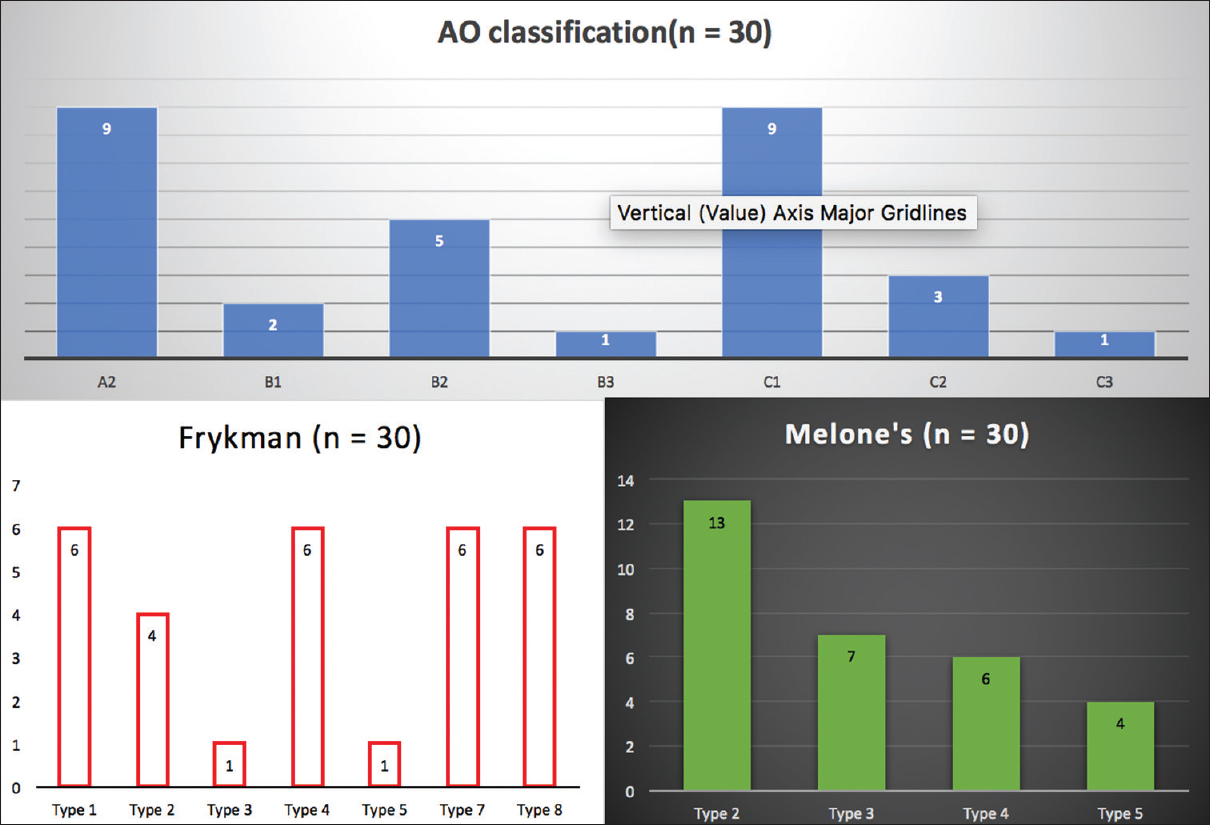
- The fracture patterns classified based on the AO, Melone's, and Frykman classification systems.
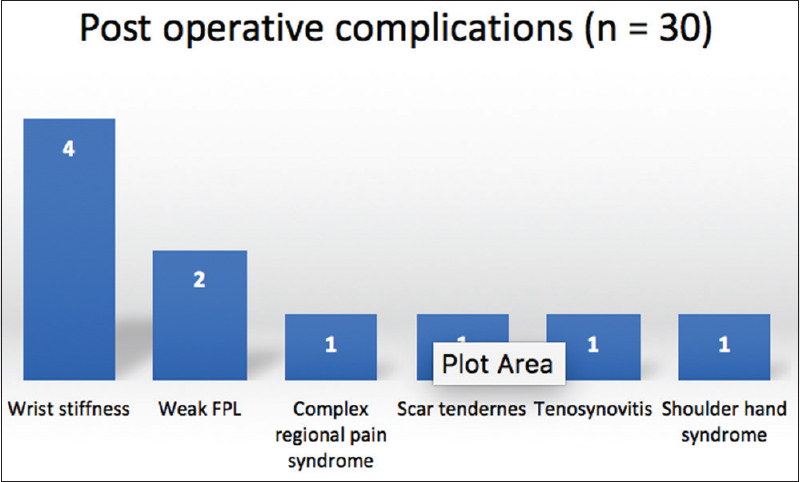
- Postoperative complications
The functional outcome was measured subjectively and objectively using the Mayo Wrist Scoring system and the Modified Clinical Scoring system of Greene and O'Brian. At the final follow-up of 6 months, the functional outcome based on the Mayo Wrist Score [Figure 3a-c] was found to be excellent in 4 (13.3%), good in 18 (60%), satisfactory in 6 (20%), and poor in 2 (6.7%). There were significant improvements in the range of motion of the wrist and grip strengths at each interval, with the most significant improvement noted in the range of radial deviation [Table 1]. An average grip strength of 82% as compared to the normal extremity was noted at the final follow-up. The two patients with poor outcome were found to have had poor compliance with physiotherapy, which manifested as shoulder hand syndrome and wrist stiffness. They also had co-existing chronic morbidities, and our study noted a significant influence of chronic comorbidities on the functional outcome. While one of these patients was operated after 33 days of initial injury, the time since injury was not found to have a statistically significant effect on the functional outcome.
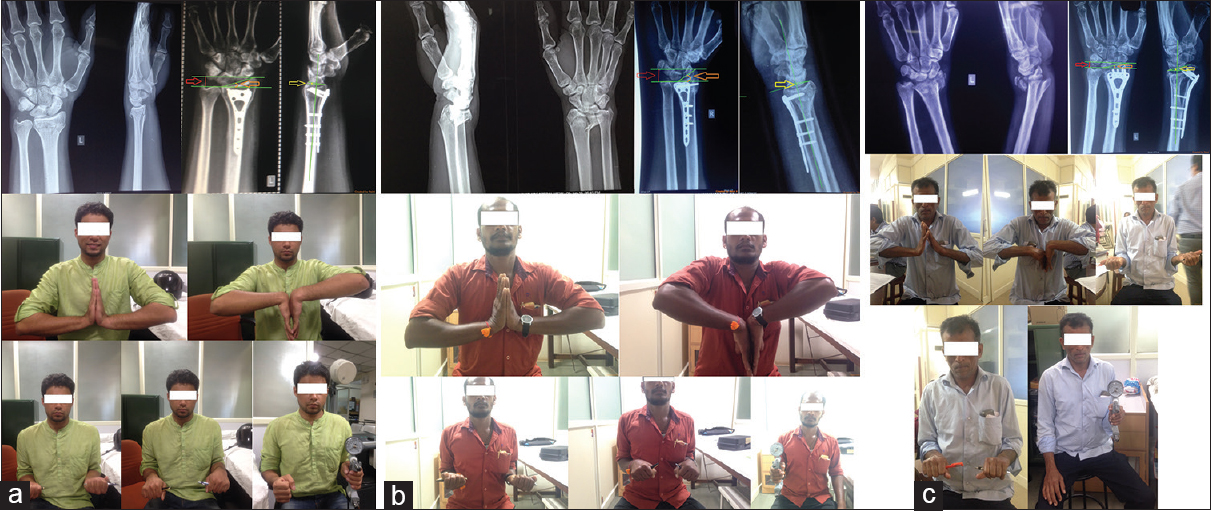
- (a) Postoperative excellent functional outcome. Pre- and post-operative X-ray with radial height (red), radial inclination (orange), and volar tilt (yellow). Clinical assessment of range of motion – extension, flexion, supination, pronation, and measurement of grip strength. (b) Postoperative poor functional outcome. Pre- and post-operative X-ray with radial height (red), radial inclination (orange), and dorsal tilt (yellow). Clinical assessment of range of motion – extension, flexion, supination, pronation, and measurement of grip strength. (c) Postoperative good functional outcome. Pre- and post-operative X-ray with radial height (red), radial inclination (orange), and volar tilt (yellow). Clinical assessment of range of motion – extension, flexion, supination, pronation, and measurement of grip strength
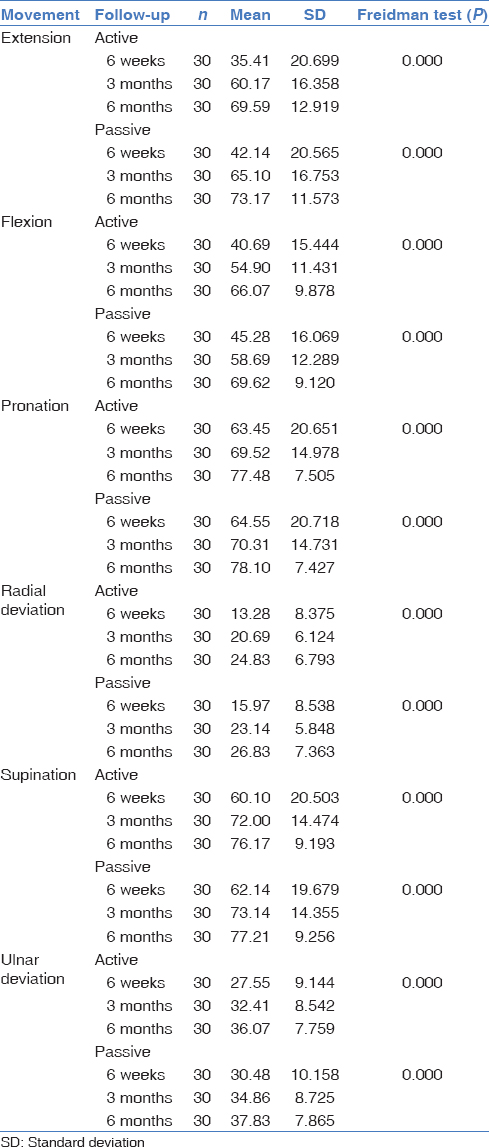
The patient's perspective of postoperative outcome was also evaluated using the PRWE questionnaire, which showed significant improvement in pain and functional outcome profiles at each follow-up interval [Table 2]. The pain scoring and restriction of function was more in those with AO type C fractures, but this was not found to be significant. The radiological outcome was evaluated based on the Sarmiento's modification of Lindstorm criteria, and it was found to be excellent in 9 (30%), good in 16 (53.3%), and fair in 5 (16.7%) at the final follow-up at 6 months. None were reported as poor outcome. The optimal radiological outcome was seen at the initial follow-up at 6 weeks; although there was further improvement at subsequent follow-ups, this was not found to be significant.

In our study, we did not find any significant association between age, sex, handedness, and dominance of the injured hand on the functional and radiological outcome at any follow-up interval. Interestingly, in this study, the fracture type, i.e., extra-articular, partial articular, or intra-articular, did not show any significant effect on the outcome. Although less favorable outcomes were more frequent in the intra-articular fractures, this was not found to be statistically significant. Good-to-excellent outcomes were seen in majority of the younger (below 50 years) and older (above 50 years) patients as well as males and females. No statistical difference could be found while comparing parameters of low- and high-energy fractures. A significant correlation was found between the functional outcome and the radiological outcome at the final follow-up at 6 months [Table 3]. The PRWE scores also had a significant and inverse correlation with the radiological outcome [Table 4]. However, the radiological outcome did not have a significant bearing on the grip strength.
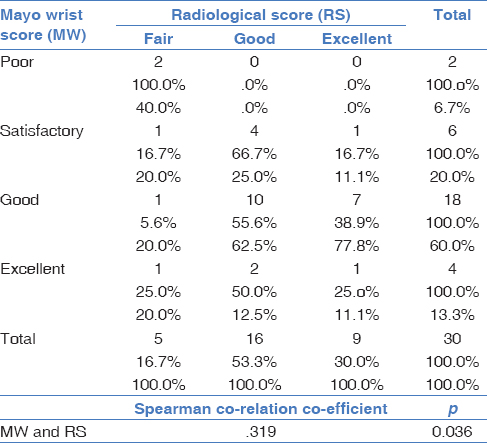
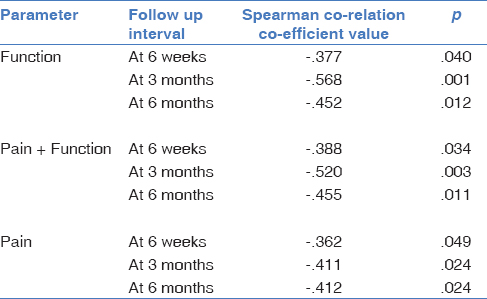
Discussion
Fractures of the distal radius can present with a wide array of fracture patterns, with variations in the extent of displacement, degree of articular disruption, and the stability and reducibility of fragments. The goal of distal radius fracture treatment is to restore hand, wrist, and forearm function with a high quality of motion and stability. It is commonly understood that distal radius fractures require accurate restoration of the anatomy as well as congruity of the articular surfaces to prevent the sequelae of posttraumatic arthritis and to achieve optimal functional utility.[17,18,19] Misalignment has been associated with reduced grip strength, decreased range of motion, and instability of the wrist.[5]
Internal stabilization of distal radius fractures, especially with a volar LCP, provides a better restoration of radiographic parameters of radial height, radial inclination, and volar tilt as compared to other treatment modalities for such injuries. It also provides a better technique to fix osteoporotic bone.[20,21] In our study, we used a 2.7-mm fixed-angle volar buttressing LCP which had an intermediate plate profile as compared to the 2.4-mm and 3.5-mm plates.
We objectively assessed the functional outcome after fixation and found good-to-excellent outcomes in the vast majority (73.3%) of patients. The same was observed with regard to radiological outcome, wherein 83.3% of patients had good-to-excellent outcome. Based on the results of serial follow-ups, our study proved that there was no significant difference in the radiographic parameters such as radial height, loss of radial inclination, and loss of volar tilt after fixation. This highlighted the fact that the fracture reduction and stabilization which was achieved immediately postoperatively was sustained throughout the duration of follow-up. Subjective assessment of the outcome using the PRWE scoring allowed us to correlate the clinical and radiological outcome with patient's perception of recovery during the follow-up period. Significant improvement was noted in the pain and functional outcome scores and these correlated inversely with the radiological outcome. Claudio Roberto Martins et al. in their study utilizing a 2.4-mm volar T plate LCP found no correlation between radiological parameters and PRWE scores.[22] However, in stark contrast, we observed that better radiographic parameters and scores using the 2.7-mm volar LCP translated in lower patient-reported pain scores and less restriction of function.
In our study population, demographic factors such as age, sex, handedness, and dominance of the injured hand had no significant bearing on the functional or radiological outcome. Koo et al. also reported no correlation between hand dominance and the fracture site.[23] The fracture type, i.e., extra-articular, partial articular, or intra-articular, including its subtypes, did not show any significant effect on the outcome at any interval. Though less favorable outcomes were more frequent in the intra-articular fractures, this was not found to be statistically significant. Similar observations were made in studies conducted by Michele Rampoldi et al.[24] and Wichlas et al.,[25] wherein they concurred that the type of fracture did not significantly correlate with the outcome. While Drobetz et al.[26] and Wright et al.[27] do not recommend volar plating for certain fracture subtypes such as B2 and C3, we found uniformly good outcomes across these fracture patterns with the 2.7-mm LCP. The mechanism of injury (high or low velocity) and time duration till surgery also did not have any significant influence.
The 2.7-mm fixed-angle volar LCP has been designed to address complex fracture patterns, more so in comminuted fractures associated with osteoporosis. Fixed-angle plate designs minimize screw loosening in the distal fragments due to the “toggling effect” and thereby reduce the danger of secondary displacement.[28] Two rows of fixation are noted in this fixation; a proximal support for the distal subchondral bone and a distal screw support for the volar central subchondral bone from the distal row using the volar locking plate in order to achieve accurate anatomical reduction.[29] Keeping in mind the three-column theory of fracture fixation, placement of multiple screws augments fixation of fractures in the three columns of distal radius.[30] The smaller profile of the plate and the locking screws help improve precision with regard to individual fracture fragments compared to the older 3.5-mm system. It is cost-effective than the 2.4-mm system, and the thin profile helps to decrease the incidence of tendon and soft-tissue irritation, thereby reducing the need for implant removal.
The major drawback of our study was the lack of randomization and comparison with other popularly used volar LCP profiles including the polyaxial variety. A randomized controlled study is required ideally to highlight the advantages of the 2.7-mm plate over other volar LCPs and modalities for distal radius fractures. A longer duration of follow-up is required to adequately assess delayed complications such as posttraumatic osteoarthrosis especially in patients with intra-articular fractures.
The advantage of this study was that all cases had been operated at a single center and by the same experienced orthopedic surgeon keeping the idea and method of fracture fixation constant. The follow-up examination was done by the same team of orthopedic surgeons, and we were able to prospectively assess our patients at fixed intervals of disease recovery, thereby eliminating recall bias. Not only was the functional and radiological outcome objectively assessed, more importantly it was correlated with patient's perspective on improvement or worsening. We believe that this study effectively demonstrates the optimal results in terms of postoperative functional and radiological outcomes with the use of 2.7-mm volar locking plate for distal radius fracture fixation.
Conclusion
The use of 2.7-mm fixed-angle buttressing type volar LCP was found to have good-to-excellent functional as well as radiological outcomes in majority of the cases. The incidence of postoperative complications was low. A significant correlation existed between the functional and radiographic outcome. Patient's self-assessment with PRWE had a significant inverse correlation with the radiological outcome. We did not find any significant association of the functional or radiological outcome with age, sex, dominance of the injured hand, and the fracture type. The presence of chronic comorbidities significantly influenced the outcome. We noted that the fracture reduction achieved in the immediate postoperative was maintained throughout the follow-up duration. However, a randomized controlled study is desirable to compare this plate and highlight its efficacy over other fixation methods.
Financial support and sponsorship
Nil.
Conflicts of interest
There are no conflicts of interest.
References
- Epidemiology of adult fractures: A review. Injury. 2006;37:691-7.
- [CrossRef] [PubMed] [Google Scholar]
- Epidemiology and time trends of distal forearm fractures in adults - A study of 11.2 million person-years in Sweden. BMC Musculoskelet Disord. 2017;18:240.
- [CrossRef] [PubMed] [Google Scholar]
- Increasing age and fractures of the distal radius. Curr Orthop. 2003;17:360-8.
- [CrossRef] [Google Scholar]
- Outcomes and financial implications of intra-articular distal radius fractures: A comparative study of open reduction internal fixation (ORIF) with volar locking plates versus nonoperative management. J Orthop Traumatol. 2017;18:229-34.
- [CrossRef] [PubMed] [Google Scholar]
- Fixation of distal radius fractures in adults: A review. Orthop Traumatol Surg Res. 2013;99:216-34.
- [CrossRef] [PubMed] [Google Scholar]
- Colles fracture: Does the anatomical result affect the final function? J Bone Joint Surg Br. 1988;70:649-51.
- [CrossRef] [PubMed] [Google Scholar]
- Surgical treatment of distal radial fractures with a volar locking plate versus conventional percutaneous methods: A randomized controlled trial. J Bone Joint Surg Am. 2013;95:1737-44.
- [CrossRef] [PubMed] [Google Scholar]
- Prospective study of distal radius fractures treated with a volar locking plate system. J Hand Surg Am. 2008;33:691-700.
- [CrossRef] [PubMed] [Google Scholar]
- Volar plating in distal end radius fractures and its clinical and radio logical outcome as compared to other methods of treatment. J Orthop Allied Sci. 2016;4:40-4.
- [CrossRef] [Google Scholar]
- Patient rating of wrist pain and disability: A reliable and valid measurement tool. J Orthop Trauma. 1998;12:577-86.
- [Google Scholar]
- Predictors of wrist function and health status after operative treatment of fractures of the distal radius. Hand Surg Am. 2008;33:157-63.
- [CrossRef] [PubMed] [Google Scholar]
- Colles' fractures. Functional bracing in supination. J Bone Joint Surg Am. 1975;57:311-7.
- [CrossRef] [PubMed] [Google Scholar]
- The Comprehensive Classification of Long Bones. New York: Springer-Verlag; 1990. p. :54-63.
- [CrossRef]
- Articular fractures of the distal radius. Orthop Clin North Am. 1984;15:217-36.
- [CrossRef] [PubMed] [Google Scholar]
- Fractures of the distal radius, including sequelae - Shoulder- and finger-syndrome, disturbance in the distal radioulnar joint and impairment of nerve function: A clinical and experimental study. Acta Orthop Scand Suppl. 1967;108:1-153.
- [CrossRef] [PubMed] [Google Scholar]
- Distal radius fractures: Current concepts. J Hand Surg Am. 2012;37:1718-25.
- [CrossRef] [PubMed] [Google Scholar]
- Do radiological and functional outcomes correlate for fractures of the distal radius? Bone Joint J. 2017;99-B:376-82.
- [CrossRef] [PubMed] [Google Scholar]
- Determinants of functional outcome in distal radius fractures in high-functioning patients older than 55 Years. J Orthop Trauma. 2016;30:445-9.
- [CrossRef] [PubMed] [Google Scholar]
- Fragment-specific fracture fixation and double-column plating of unstable distal radial fractures using AO mini-fragment implants and Kirschner wires. Injury. 2007;38:1259-67.
- [CrossRef] [PubMed] [Google Scholar]
- Palmar plate fixation of AO type C2 fracture of distal radius using a locking compression plate - A biomechanical study in a cadaveric model. J Hand Surg Br. 2003;28:263-6.
- [CrossRef] [Google Scholar]
- Surgical treatment of distal radius fractures with a volar locked plate: Correlation of clinical and radiographic results. Rev Bras Ortop. 2011;46:505-13.
- [CrossRef] [Google Scholar]
- Distal radius fractures: An epidemiological review. Orthop Surg. 2013;5:209-13.
- [CrossRef] [PubMed] [Google Scholar]
- Distal radius fractures with diaphyseal involvement: Fixation with fixed angle volar plate. J Orthop Traumatol. 2011;12:137-43.
- [CrossRef] [PubMed] [Google Scholar]
- Complication rates and reduction potential of palmar versus dorsal locking plate osteosynthesis for the treatment of distal radius fractures. J Orthop Traumatol. 2014;15:259-64.
- [CrossRef] [PubMed] [Google Scholar]
- Osteosynthesis of distal radial fractures with a volar locking screw plate system. Int Orthop. 2013;27:1-6.
- [CrossRef] [PubMed] [Google Scholar]
- Functional outcome of unstable distal radius fractures: ORIF with a volar fixed-angle tine plate versus external fixation. J Hand Surg. 2005;30:289-99.
- [CrossRef] [PubMed] [Google Scholar]
- Distal radius fractures-design of locking mechanism in plate system and recent surgical procedures. J Orthop Sci. 2016;21:258-62.
- [CrossRef] [PubMed] [Google Scholar]
- Volar fixation of dorsally displaced distal radial fracture using locking compression plate. J Orthop Surg (Hong Kong). 2005;13:153-7.
- [CrossRef] [PubMed] [Google Scholar]
- Functional outcomes of distal radius fractures with and without ulnar styloid fractures: A meta-analysis. J Hand Surg Eur. 2018;43:150-7.
- [CrossRef] [PubMed] [Google Scholar]






